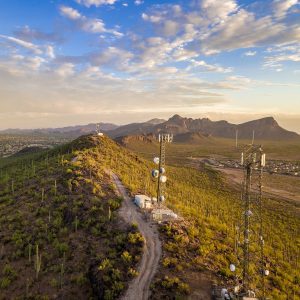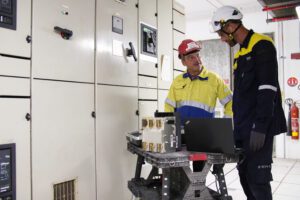In this post, we will look at how a digital twin can be used in a power analytic platform to enhance resilience. This is the fourth post in my series about how power analytics in the ‘New Electric World’ can make complex electrical distribution systems more resilient and efficient. In my last post we looked at how power analytics are used at every level, from devices to edge control systems to the cloud.

Types of digital twins supporting power analytics
A digital twin is a digital representation of a physical asset or system. The concept is not new, but, with recent advances in IoT, machine learning, and augmented and virtual reality (AR/VR), digital twins have moved into the mainstream.
- Asset Digital Twins. At the asset level, a digital twin can model the performance of power equipment like a protective relay, a transformer, or a generator. These assets are designed, built, and operated in heavily digitized environments, using the technologies mentioned above. Because of this, there are several mature applications for asset digital twins. We’ll talk about these applications in the following sections.
- System Digital Twins. Digital twins can also be used to model systems such as electrical networks, industrial production lines, or complete facilities. Compared to asset digital twins, system digital twins are less mature because of the diversity and complexity of data required for an accurate model. As noted by industry analyst Deloitte, “Digital twins are multiplying as their capabilities and sophistication grow. But realizing their full promise may require integrating systems and data across entire organizational ecosystems.”
Digital twin applications for power management
There are four core applications for digital twins in power management: diagnostics, simulation, prediction, and prescription.
Diagnostics
In a diagnostics application, digital twins identify what happened and why. After a power outage has occurred, an engineer will attempt to determine the root cause and then build a mitigation plan to prevent it from happening again. During this investigation, the engineer will use a power management platform to analyze reports, charts, and tables to understand what happened. With a system digital twin approach, the power management platform is built on top of a model of the actual electrical network itself. This introduces new workflows that find the root cause faster. For example, it allows the engineer to replay an incident step-by-step, inspecting measurements on any part of the network at any time. Those same measurements from the real system can also be fed as inputs into asset digital twins to determine if the asset (e.g. a breaker) operated correctly, or why it did not. Overall, these capabilities can reduce the time spent in diagnosis from hours to minutes.
Simulation
Digital twins allow you to run simulations before you act on the real system or asset. This opens powerful applications for training and maintenance. Consider a new employee scheduled to visit an industrial substation to maintain transformers. The maintenance requires isolating each transformer from the utility and powering the downstream feeder from another transformer. This complex set of operations can be fully simulated on the substation digital twin before the employee leaves her office. Once onsite, with a connection to the digital twin, she can re-verify her planned actions just before she takes them.
Designing new electrical networks for large facilities is another important application where digital twins add value. Automation and control schemes, communication architectures, and switchgear and cabling layouts benefit from being tested and validated in a digital twin simulation before investing in costly construction and commissioning.
Prediction
Predictive maintenance is one of the most common uses of digital twins today. For example, a digital twin of a generator can tell you when maintenance is needed based on comparing the predicted behavior to the actual behavior. Is oil temperature hotter than the digital twin expects? Then it is time for maintenance.
Facility energy use forecasting and validation is another common prediction application. Here, the digital twin of the facility is fed with the process, occupancy, temperature, or other driver variables. The facility digital twin outputs the expected energy consumption over the next day, week, or season. This data can justify investments, confirm the facility is operating as expected, or validate investments made in the past.
Prescription
Imagine a future where you ask a digital twin to recommend how to improve uptime in a production line, or what extra steps are required to achieve a level of cyber security compliance for your power management system. In these examples, digital twins are used to prescribe actions. The technology required to deliver these applications is not yet mature. Delivering this capability at scale will require advances not just in asset or system digital twins, but perhaps in the digital twins of organizations and ecosystems.
Digital twins over the lifecycle
As we have seen in the previous section, digital twins play a role in the design stage of a product (i.e. asset) or system, as well as in the construction, commissioning, operation, and maintenance stages.
Thanks to the digital backbone of most supply chains, the data created in the design stage of a system or asset can feed the digital twin applications in the downstream stages. This propagation of data through the lifecycle is called a digital thread. Standard data interchange formats, cross-vendor tool compatibility and secured data transfer and ownership are key to unlocking the benefits of a digital thread approach. In the future, we can expect industrialized digital thread solutions to work together with digital twins, providing dramatic improvements in project delivery time and in operational performance.
Learn about power analytics, EcoStruxure, and much more
The IoT-enabled, future-proof EcoStruxure™ Power architecture from Schneider Electric supports digitized power distribution, enabling enhanced connectivity, real-time operations, and smart power analytics. EcoStruxure Power Advisor is a proactive, analytics-based service for your power management system, delivering optimized energy performance, power reliability, and resilience.




Conversation
Very interesting modern subject.
Good to know about predictive maintenance.